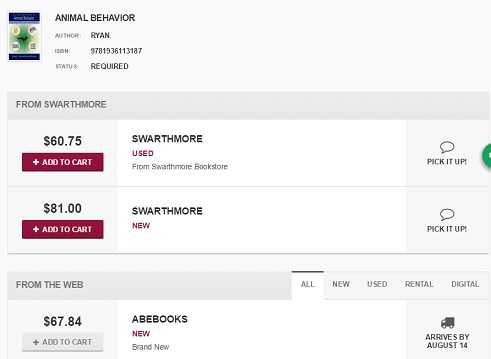Leaders discuss how the college bookstore is becoming a tech-enabled, data-rich cornerstone of campus life.
 They still sell t-shirts for proud parents and coffee mugs with catchy slogans, but college bookstores are also going through a renaissance of sorts, using technology-supported measures to become an integral cornerstone of campus life.
They still sell t-shirts for proud parents and coffee mugs with catchy slogans, but college bookstores are also going through a renaissance of sorts, using technology-supported measures to become an integral cornerstone of campus life.
It’s what Ed Schlichenmayer, deputy CEO of the National Association of College Stores (NACS), and chief operating officer (COO) of indiCo (a NACS subsidiary), calls a system based on trust equity.
Despite booming online marketplaces for college textbooks–like Amazon, CourseSmart and BookFinder.com—“75 percent of course material transactions stay with the college bookstore,” said Schlichenmayer. “And that’s based on the trust equity they’ve built throughout the entire campus community.”
A reinvention’s beginning
According to Schlichenmayer, multiple drivers propelled college bookstores to reimagine how they work with students and faculty to procure needed course materials, including: pressure from online publishing, heavy use of used materials, the surge in rental platforms, and non-traditional wholesale options.
However, one of the major initial motivations to update practices began with the Higher Education Act’s (HEA) suggested guidelines to promote earlier adoption of course materials on campus.
“Five years ago, HEA added a guideline that urged colleges to adopt course materials at an earlier stage,” explained Jenny Febbo, vice president for strategic communications for NACS. “Faculty were asked to find and choose the materials required for their courses months before a student actually began the course. This gives college bookstores more time to find alternative options to new, printed books, as well as help drive down the overall cost for students by giving them the information they need to comparatively shop and consider their campus budgeting.”
And though the guideline was included in the HEA five years ago, “colleges had a two-year implementation window, so we’re really seeing the uptick in these practices within the last three years,” Schlichenmayer noted.
(Next page: How tech-enabled practices build trust equity across campus)
Incorporating tech-enabled practices
One of the critical ways college bookstores are building trust with the student community is by using an online price comparison tool part of the bookstore’s website.
“A price comparison tool part of the college bookstore’s website is quickly becoming a critical component, and usually consists of a set of subscription-based apps, or a software, that’s integrated with various e-commerce systems,” said Schlichenmayer. “A product’s identifying information is readily available on the online open market and that’s where the tech gathers information.”
Swarthmore College offers just one example of a price comparison tool via a college bookstore website. The website, which writes on its homepage that its main mission is to benefit the campus community, includes a “Textbook Price Comparison Tool” that includes price information from major online textbook retailers, such as Amazon, Abebooks, and Half.com.
“We strive to get you the lowest price on textbooks. Sometimes, however, another online source can beat our price…let our [tool] do the research for you,” says the tool’s description.
Clicking on the comparison tool, students choose the term, department, course, and then the title/professor of the course.
Randomly selecting Fall 2015, Biology, 030, and “Animal Behavior (Baugh),” the comparison tool shows all books that are required reading for the course. And though Swarthmore’s used version of the required textbook is the cheapest version, new versions of the textbook are cheaper on Abebooks and Alibris than via Swarthmore. The tool also lets students know when the course material will arrive if ordered immediately from the various sites.
“These tools not only help students, it helps faculty,” said Schlichenmayer. “When faculty give bookstores information on their required materials, the bookstore can plug it into the software and see what the price is, as well as comparative shop on similar texts and formats. Bookstores can then give that information to faculty to help them make the most informed choices on their required texts for students, with the goal of ultimately saving students money.
According to the NACS Spring 2015 edition of their twice-yearly survey on student spending, the early-textbook-information practice seems to be working: the average annual spending from surveyed college students on required materials has dropped from $701 in 2007-2008 to $563 in 2014-2015 (down $75 from 2013-2014’s $638 average), with “faculty working with campus stores to source less costly materials in use for multiple semesters” listed as one of the major factors contributing to the student spending decline.
Another way Schlichenmayer says college bookstores’ tech-supported practices help faculty make informed course material decisions is by harnessing the data available via digital and online course materials.
“Most people think when you say ‘digital course materials’ that you mean e-books, but higher education has really leapfrogged to interactive, analytics-based digital materials,” he emphasized. “If a faculty member chooses to use a digital textbook that has the capability to monitor data—such as amount of time used by the student, ideas highlighted and looked-up by the student, proficiency on assessments offered by the textbook, etc.—the bookstore can work with the publisher to have access to that data (organized into broad general trends) and let faculty members know which texts are the most used, which are the hardest to potentially comprehend, which help in succeeding on assessments, and more.”
Schlichenmayer noted, however, that not all faculty may want this data, explaining that first the faculty has to choose an analytics-enabled course material, then the bookstore has to gain access to the data (which may include a fee), and “many faculty may see this process and data aggregation as intrusive for not only their course but for their students.”
(Next page: Better cross-campus partnerships; future possibilities)
Though technology may be a support tool, it really all goes back to building the concept of trust equity across the whole campus, said Schlichenmayer.
Outside of faculty and students, college bookstores are also working more closely with often budget-strapped campus libraries.
“We’re seeing more bookstores work in close partnership with campus libraries to figure out which materials the bookstore can supply, and at what cost, versus what the library can rent or lend to students and in what formats; it’s really a more collaborative effort,” he explained.
Looking ahead
In the future, Schlichenmayer says he sees college bookstores looking more into wholesale support for textbook affordability, especially in terms of open educational resources (OER) and online formats, as well as becoming bigger supporters of the institution’s overall academic mission.
“College bookstores will become even more entrenched in campus culture, providing critical services for students that will help in recruitment, retention and alumni engagement.”
For example, going back to Swarthmore, the college’s bookstore not only sells course materials and the usual fare, but includes a “technology e-store,” where, among other things, the campus community can purchase Microsoft Office starting at a reduced price of $79.98.
“The bottom line is that college bookstores are positioning themselves as a trusted campus partner that really understands student and faculty needs and weaves those needs-based services into the fabric of the institution,” he concluded. “They’re there to build and maintain mission and brand and will become even more integral to campus life in the next five-to-ten years.”
- 25 education trends for 2018 - January 1, 2018
- IT #1: 6 essential technologies on the higher ed horizon - December 27, 2017
- #3: 3 big ways today’s college students are different from just a decade ago - December 27, 2017


